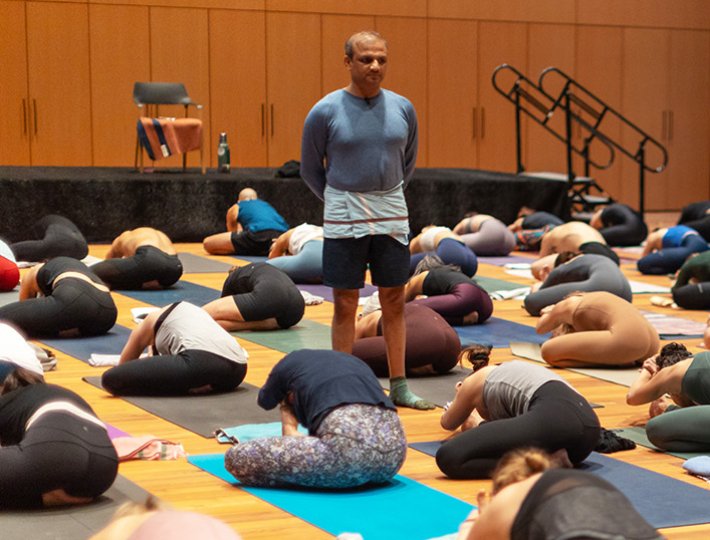Here’s one theory that explains why going to yoga class feels so good: It fulfills all five principles of what Tal Ben-Shahar, Ph.D., and Megan McDonough, cofounders of the Wholebeing Institute, call the SPIRE model. It’s a philosophy of living that teaches that, in order to be happy, healthy people, we must attend to each of these five equally important aspects of our life: Spiritual, Physical, Intellectual, Relational, and Emotional.
In other words, true happiness, contrary to outdated notions of psychology, isn’t just about the thoughts we think: It depends on the whole—how we hold our body (which in turn affects what’s happening in the cells), how we connect with others, and whether we have a sense of greater purpose in our lives.
The SPIRE model integrates concepts and research from both positive psychology (Ben-Shahar is a leading speaker and author in the field, whose course at Harvard was one of the university’s most popular ever) and yoga (McDonough, the CEO, is a longtime yoga instructor, as well as the author of Radically Receptive Meditation and other books). Founded in 2013, Wholebeing Institute is named for their synthesis of the phrase “whole-person well-being”; to achieve that enviable state, they say, we must find ways to nurture growth, inspiration, and pleasure in all five SPIRE dimensions.
“To experience wholebeing—to live life to its fullest and fulfill our potential for deep and lasting happiness—we cannot thrive in some of the dimensions while neglecting the rest,” Ben-Shahar says. “The five elements are interconnected and affect one other.”
Let’s take them one by one, in the context of that yoga class:
Spiritual: McDonough emphasizes that this dimension of the SPIRE model doesn’t necessarily have anything to do with God or religion (thought it might for some people). Rather, it’s about finding a sense of purpose and meaning in life. We can find that in yoga class through the activity of mindfully linking breath and movement, which connects us with ourselves and with that reservoir of peaceful stillness that lies beneath the tumultuous surface of everyday life. “By being mindful, we can turn the mundane into the meaningful, recognizing that this life is special and worthy of our attention.,” McDonough says.
Physical: A myriad of studies has shown that how we sleep, what we eat, and how much we exercise all impact how happy we feel on a daily basis. McDonough quotes Martin Seligman, known as the father of positive psychology: “The problem with psychology today is that we focus too much on neck up, whereas most of what happens to us is neck down.” How yoga enters this equation is self-explanatory: Though we often talk about yoga as so much more than exercise, there’s no denying that moving is part of what we love about the practice. In addition, studies show that the flowing movements of yoga, synchronized with breath, activate the parasympathetic nervous system.
Intellectual: Stimulating our minds with activities that foster learning and creativity is a powerful way to increase well-being, according to the SPIRE model. In a yoga class, that might mean fine-tuning your understanding of a posture, listening to your teacher read from the Yoga Sutras or another text, or finding new ways to play with a familiar posture. “As we become adults, paying attention to what we find naturally interesting is a key part of our overall well-being,” says Ben-Shahar. “What captivates our curiosity feeds our inquisitive nature as much as food feeds our physical nature.”
Related: How Living in the Moment Can Help You Be Happier
Relational: This dimension refers to the give and take among family members, work colleagues, and even strangers. Studies show that small, seemingly meaningless encounters—like exchanging a few pleasant words with your barista instead of rushing through the interaction—can lead to a sense of belonging and positivity. In yoga class, that might manifest in a number of ways: through the power of practicing together as a sangha, in the smiles and positive vibes you share with your fellow practitioners before and after class, or in the appreciation you offer your teacher for her loving guidance.
Emotional: We all ride the ups and downs of our personal roller coaster, but learning how to come back to equilibrium is the key to emotional well-being. That ability to return to a centered state after stressful times is known as resilience, which is the specialty of Maria Sirois, Wholebeing Institute’s Vice President of Curriculum and a faculty member at Kripalu Center for Yoga & Health, where she teaches the blended-learning program Crafting the Resilient Life. “Resilience is a choice we make each time we lead from our strengths, practice mindfulness, gather wisdom from our failures, and make small changes that elevate our health, happiness, and sense of inner calm,” Sirois says. Taking that back to the mat, yoga has been shown to increase the capacity to self-regulate our thoughts, feelings, and behaviors.
But more than an occasional yoga class is required to raise our happiness levels, Sirois says. The key is finding ways to nurture these five dimensions on a daily basis, by integrating new, positive routines and habits into our lives—or by bringing greater awareness to activities that you already engage in regularly. For example, Ben-Shahar describes his weekly dinner with family as an experience that fulfills all the SPIRE dimensions. What do you already do that is contributing to your well-being? Simply recognizing what makes you happier is the first step. Next, take action to bring more of it into your life. It might be just that simple.









Comments (0)